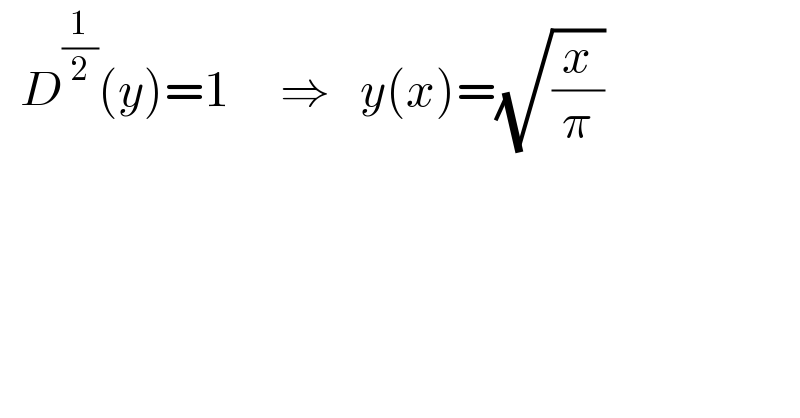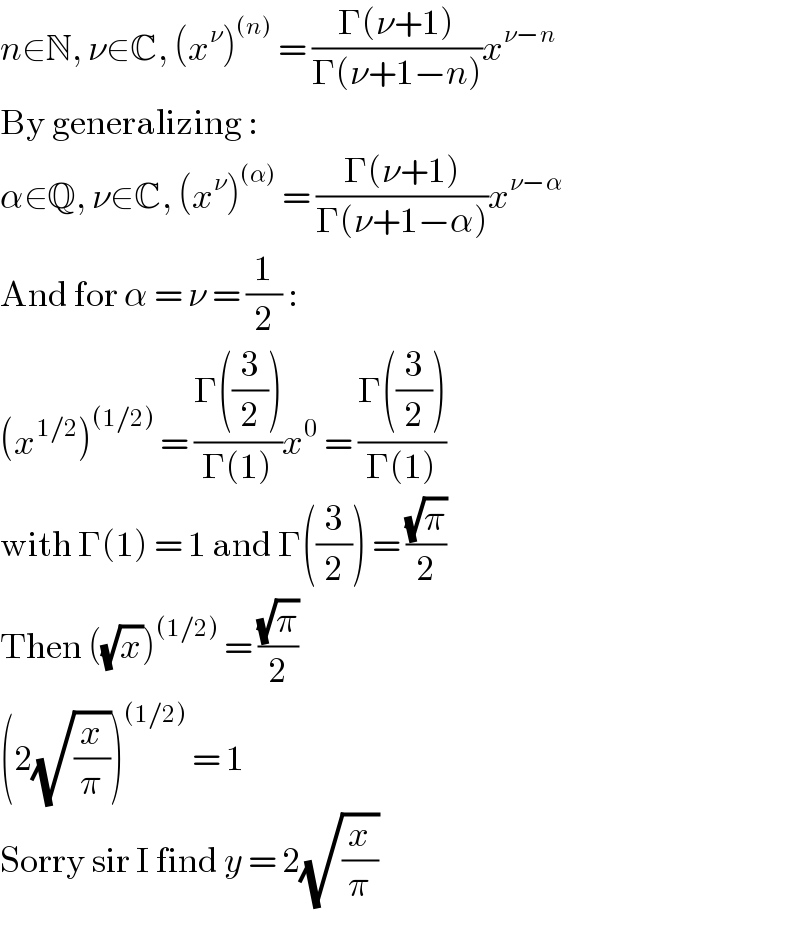Question Number 104608 by ~blr237~ last updated on 22/Jul/20

$$\:\:{D}^{\frac{\mathrm{1}}{\mathrm{2}}} \left({y}\right)=\mathrm{1}\:\:\:\:\:\Rightarrow\:\:\:{y}\left({x}\right)=\sqrt{\frac{{x}}{\pi}} \\ $$
Answered by OlafThorendsen last updated on 22/Jul/20

$${n}\in\mathbb{N},\:\nu\in\mathbb{C},\:\left({x}^{\nu} \right)^{\left({n}\right)} \:=\:\frac{\Gamma\left(\nu+\mathrm{1}\right)}{\Gamma\left(\nu+\mathrm{1}−{n}\right)}{x}^{\nu−{n}} \\ $$$$\mathrm{By}\:\mathrm{generalizing}\:: \\ $$$$\alpha\in\mathbb{Q},\:\nu\in\mathbb{C},\:\left({x}^{\nu} \right)^{\left(\alpha\right)} \:=\:\frac{\Gamma\left(\nu+\mathrm{1}\right)}{\Gamma\left(\nu+\mathrm{1}−\alpha\right)}{x}^{\nu−\alpha} \\ $$$$\mathrm{And}\:\mathrm{for}\:\alpha\:=\:\nu\:=\:\frac{\mathrm{1}}{\mathrm{2}}\:: \\ $$$$\left({x}^{\mathrm{1}/\mathrm{2}} \right)^{\left(\mathrm{1}/\mathrm{2}\right)} \:=\:\frac{\Gamma\left(\frac{\mathrm{3}}{\mathrm{2}}\right)}{\Gamma\left(\mathrm{1}\right)}{x}^{\mathrm{0}} \:=\:\frac{\Gamma\left(\frac{\mathrm{3}}{\mathrm{2}}\right)}{\Gamma\left(\mathrm{1}\right)} \\ $$$$\mathrm{with}\:\Gamma\left(\mathrm{1}\right)\:=\:\mathrm{1}\:\mathrm{and}\:\Gamma\left(\frac{\mathrm{3}}{\mathrm{2}}\right)\:=\:\frac{\sqrt{\pi}}{\mathrm{2}} \\ $$$$\mathrm{Then}\:\left(\sqrt{{x}}\right)^{\left(\mathrm{1}/\mathrm{2}\right)} \:=\:\frac{\sqrt{\pi}}{\mathrm{2}} \\ $$$$\left(\mathrm{2}\sqrt{\frac{{x}}{\pi}}\right)^{\left(\mathrm{1}/\mathrm{2}\right)} \:=\:\mathrm{1} \\ $$$$\mathrm{Sorry}\:\mathrm{sir}\:\mathrm{I}\:\mathrm{find}\:{y}\:=\:\mathrm{2}\sqrt{\frac{{x}}{\pi}} \\ $$
Commented by ~blr237~ last updated on 23/Jul/20

$${yes}\:{it}'{s}\:{correct}\::\:{error}\:{of}\:{typo} \\ $$$${But}\:{you}\:{didn}'{t}\:{prove}\:{the}\:{proposition}\:{only}\:{its}\:{interplay}\: \\ $$$${That}\:{generalisation}\:{is}\:{also}\:{correct}\:\left(\:{it}'{s}\:{the}\:{Caputo}\:{derivation}\right)\:{and}\:{that}\:{coincides}\:{with}\:{the}\:{Riemann}-{Liouville}\:{derivation}\:{when}\:\alpha=\frac{\mathrm{1}}{\mathrm{2}}\: \\ $$$${D}^{\alpha} \left({f}\right)\left({x}\right)=\frac{\mathrm{1}}{\Gamma\left(\alpha\right)}\:\frac{{d}}{{dx}}\left(\int_{\mathrm{0}\:} ^{{x}} {t}^{\alpha−\mathrm{1}} {f}\left({x}−{t}\right){dt}\right)\:\:\:\:\:\:\mathrm{0}<\alpha \\ $$$${D}^{\frac{\mathrm{1}}{\mathrm{2}}} \left({y}\right)=\mathrm{1}\Rightarrow{D}^{\frac{\mathrm{1}}{\mathrm{2}}} \left({D}^{\frac{\mathrm{1}}{\mathrm{2}}} \left({y}\right)\right)={D}^{\frac{\mathrm{1}}{\mathrm{2}}} \left(\mathrm{1}\right) \\ $$$$\:\:\:\Rightarrow\:{y}'\left({x}\right)=\:\frac{\mathrm{1}}{\Gamma\left(\frac{\mathrm{1}}{\mathrm{2}}\right)}\:\frac{{d}}{{dx}}\left(\:\mathrm{2}\sqrt{{x}}\:\right) \\ $$$$\Rightarrow{y}\left({x}\right)=\mathrm{2}\sqrt{\frac{{x}}{\pi}}\:\:\: \\ $$
